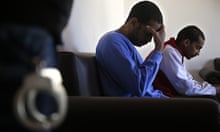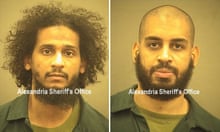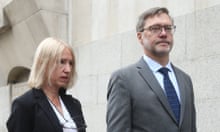Two British Isis militants implicated in brutal acts of torture and execution, have been captured by US-backed Kurdish fighters in Syria.
The two men, Alexanda Kotey and El Shafee Elsheikh, formed part of a group of four fighters nicknamed “the Beatles” due to their British accents and are allegedly responsible for murdering approximately two dozen hostages in Syria.
Kotey, a 34-year-old convert to Islam who grew up in west London, and 29-year-old Elsheikh, whose family fled to the UK from Sudan in the 1990s, were the only remaining members of the group still at large.
The group’s leader, Mohammed Emwazi, nicknamed Jihadi John, was killed in a 2015 airstrike. Emwazi was believed to be the militant responsible for the gruesome beheadings of journalists James Foley and Steven Sotloff, which were captured on film and distributed in Isis propaganda videos.
The group’s fourth member, Aine Davis, was convicted on terror charges last year in Turkey.
The capture was first reported by the New York Times and independently confirmed by the Guardian.
Citing unnamed US officials, the Times reported the two men were captured by the American-backed Kurdish militia the Syrian Democratic Forces, operating south of the Euphrates river, close to the Syria-Iraq border.
Two US officials also confirmed the capture to Reuters. The two men were captured in early January, and US forces were given access to them, one of the officials told the news agency.
Quick GuideThe four Isis 'Beatles'
Show
Mohammed Emwazi
Emwazi, nicknamed Jihadi John, was the cell’s most notorious member. He appeared in videos depicting the beheadings of western hostages, including US journalists, Steven Sotloff and James Foley. Born in Kuwait, he moved to Britain as a boy. Emwazi attended state schools in London, then studied computer science at the University of Westminster before leaving for Syria in 2013. He was killed in a 2015 airstrike when aged in his mid-20s.
Aine Davis
Davis, a former driver and drug dealer, is thought to have converted to Islam shortly after being jailed in the UK in 2006 for possessing a firearm. He prayed at the same west London mosque as Emwazi. Davis, in his mid-30s, took the name Hamza and travelled the Middle East. He is believed to have travelled to Syria in late 2012. He was convicted on terror charges last year in Turkey.
El Shafee Elsheikh
Elsheikh’s family fled to the UK from Sudan in the 1990s. He preached from a stall outside Shepherds Bush tube station after being radicalised in a very short space of time. The 29-year-old travelled to Syria in 2012, according to the US state department. It said he had “earned a reputation for waterboarding, mock executions, and crucifixions while serving as an Isis jailer”.
Alexanda Kotey
Kotey is described as of Ghanaian and Greek-Cypriot background. He was raised as a Greek Orthodox Christian in west London and was a dedicated Queen’s Park Rangers fan. The 34-year-old, believed to be a father of two, reportedly converted to Islam as a teenager, at which point he met Emwazi. As well as operating as a guard for the “Beatles” cell, he is alleged to have been responsible for recruiting several British nationals to fight for Isis.
The SDF gave US special forces access to the two men after suspecting they were foreign fighters, the Times reported. Their identities were then confirmed using fingerprints and other biometric measures.
US officials were reportedly made aware of the capture in mid-January. Both men have supplied valuable intelligence to military interrogators about the remaining Isis leadership structure, the Times reported, citing an unnamed official.
According to a state department’s terrorist designation, Kotey operated as a guard for the “Beatles” cell and “likely engaged in the group’s executions and exceptionally cruel torture methods, including electronic shock and waterboarding”.
The state department says Kotey was also responsible for recruiting several British nationals to fight for Isis.
Elsheikh travelled to Syria in 2012, according to the state department, who noted the militant had “earned a reputation for waterboarding, mock executions, and crucifixions while serving as an Isis jailer”.
The US Department of Defense and the US state department did not immediately respond to a request for comment.
British intelligence agencies and Scotland Yard’s counter-terrorism command have been closely involved in efforts to gather information on Britons who joined Isis.
A spokesperson for the Foreign and Commonwealth Office in London declined to discuss reports, but notably did not deny them.
The FCO was coordinating the response to media inquiries about the reported capture for UK law enforcement, intelligence agencies and government departments. Such an arrangement would be unusual if the reports were incorrect and indeed the two wanted extremists had not been captured.
A spokeswoman for the UK Foreign and Commonwealth Office spokeswoman said: “We do not comment on individual cases or ongoing investigations.”
How the two militants might face justice remains unclear. The Times report indicated the two men were not yet in US military custody and the US justice department did not immediately respond to questions over whether they would seek to prosecute the men in federal court.
In a reversal of Obama-era policy, the Trump administration has pushed for accused militants to be remanded in military prison. During his State of the Union address last month Donald Trump announced he had signed an executive order to keep open the detention facility at Guantánamo Bay and opened the door to sending new prisoners to the controversial centre.
“I am asking Congress to ensure that in the fight against Isis and al-Qaida we continue to have all necessary power to detain terrorists wherever we chase them down, wherever we find them. And in many cases, for them, it will now be Guantánamo bay,” Trump said.
Such a move would likely be met with sharp criticism due to the centre’s fraught international image.









